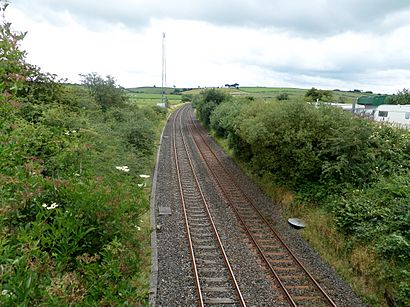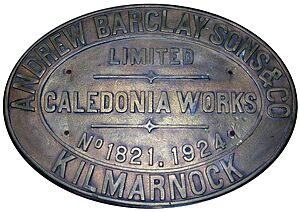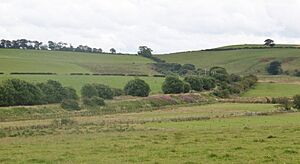Garrochburn Goods Depot facts for kids
Quick facts for kids
Garrochburn Goods Depot
|
|
|---|---|

The site of Garrochburn Goods Depot
|
|
| Location | Near Mauchline, Ayrshire Scotland |
| Coordinates | 55°32′35″N 4°24′40″W / 55.543°N 4.411°W |
| Platforms | 0 |
| Other information | |
| Status | Disused |
| History | |
| Original company | GPK&A |
| Pre-grouping | G&SWR |
| Post-grouping | LMS |
| Key dates | |
| Circa 1928 | Opened |
| 4 October 1965. | Goods services withdrawn |
Garrochburn Goods Depot was a special railway area where trains loaded and unloaded goods. It was also known as Garrochburn Siding. This depot was located near a small village called Crosshands, not far from Mauchline in East Ayrshire, Scotland.
The depot helped transport important items for local farms and industries. It was first set up by the Glasgow and South-Western Railway company. Garrochburn Goods Depot was about 40.4 miles (65 km) from Glasgow. It was also 6.82 miles (11 km) from Kilmarnock and 2.72 miles (4.4 km) from Mauchline.
Even though it's a quiet place today, this depot was once very busy. It handled things like lime for farm fields, and moved cattle, horses, and sheep. It also helped deliver milk and transport coal. There were other railway lines nearby, including one that went to Mauchline Colliery, a coal mine. That mine opened in 1925 and closed in 1969.
How the Depot Worked
Old maps from 1895 show that Garrochburn had a signal box and signals. A signal box is a small building where railway workers controlled train movements using signals and track switches.
By the 1920s, the depot had a few important features. It had a double track main line for trains. There was also a special siding, which is a shorter track, that led to a loading dock. This dock was where goods were loaded onto or unloaded from trains. The depot also had a weighing machine and small buildings. A road from the B744 allowed vehicles to access the site.
The signal box was on the eastern side of the main line. It had several tall signal posts and points that allowed trains to switch tracks. The signal box was usually staffed day and night during the week. It was open for shorter hours on Sundays.
Trains heading towards Mauchline would collect goods from Garrochburn. Trains coming from the other direction could drop off goods. The railway staff had special rules to make sure this was done safely. For example, they had to make sure wagons didn't roll away when the engine uncoupled.
The siding at Garrochburn was also used to move coal. This coal came from or went to the nearby Mauchline Colliery.
History of Garrochburn Depot
The Garrochburn goods depot was opened around the 1920s by the Glasgow and South-Western Railway. It closed its doors on October 4, 1965. The depot might have been built because of work on the nearby Mossgiel Tunnel in the mid-1920s. It was officially set up to handle both goods and livestock (farm animals).
The railway line itself was first opened by the Glasgow, Paisley, Kilmarnock and Ayr Railway. Later, it became part of the Glasgow and South-Western Railway. In 1923, many railway companies in Britain joined together. This event was called the "Grouping." After the Grouping, the line became part of the London, Midland and Scottish Railway (LMS). Finally, in 1948, it became part of British Railways.
Another small railway stop called Mossgiel Tunnel Platform was also nearby. It closed sometime after July 1926. This was after the reconstruction of Mossgiel Tunnel was finished.
Besides farm traffic, the Garrochburn siding was very important for coal transport. It helped move coal to and from the Mauchline Colliery.
What the Site Looks Like Today
Today, the railway siding at Garrochburn is gone. The signal box, track switches, and weighing machine have also been removed. Now, only the plain double track remains.
The edge of the railway site is now lined with trees. The old entrance from the B744 road has a private sign that says 'Garrochburn Sidings'. The area is currently used to store mobile caravans.



